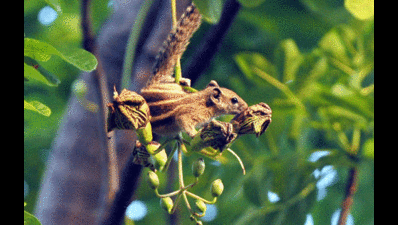- News
- City News
- jaipur News
- Flying squirrels a big attraction in Lake City
Trending
This story is from June 23, 2016
Flying squirrels a big attraction in Lake City
Udaipur division in Rajasthan boasts of these amazing creatures gliding either at Seeta Mata sanctuary in Pratapgarh district or Phulwari wildlife sanctuary lying between Kotra-Jhadol blocks in Udaipur. According to forest officials, Udaipur is the western most limit of the distribution of the Large Brown Flying Squirrel in India.

(Representative image)
Key Highlights
- Udaipur is the western most limit of the distribution of the Large Brown Flying Squirrel in India.
- These squirrels are the biggest attraction of the two forests here as large number of tourists come here especially to see these squirrels.
- The forest dwellers feared and mistook them as ghosts before these mammals found an entry in the official records.
Udaipur: Udaipur division in Rajasthan boasts of these amazing creatures gliding either at Seeta Mata sanctuary in Pratapgarh district or Phulwari wildlife sanctuary lying between Kotra-Jhadol blocks in Udaipur. According to forest officials, Udaipur is the western most limit of the distribution of the Large Brown Flying Squirrel in India.
"These squirrels are the biggest attraction of the two forests as large number of tourists from far and wide come here especially to see the squirrels gliding from one tree to another.There are over 100 squirrels, or mor chitri, as the tribal Bhil community calls them in local dialect, in Seeta Mata sanctuary and an equal or even bigger number may be found in Phulwari forest," said Rahul Bhatnagar, chief conservator of forest.
Mahua trees are said to be the reason for the squirrel species being found here in plenty. They love to eat the tender leaves of this tree. Second reason behind their good rate of survival is lack of meat value for the forest dwellers. "Its feeding activities are nocturnal and, therefore, it hides during the day time in its hole in a mahua tree. The best time to watch them is between February and March, when most of the mahua trees shed their leaves and it is easier to spot the squirrels gliding between branches of leafless trees," Bhatnagar said.
The tale of discovery of the flying squirrel is not less interesting. The forest dwellers feared and mistook them as ghosts before these mammals found an entry in the official records.
"In June 1979, we took an expedition to the jungles of Dhariyavad (now in Pratapgarh) to explore the legend. Our base camp was near Aarampura village where earlier the entire population was wiped out by an epidemic. When we reached, the village was abandoned. Some of the tribals claimed that there was a spirit that resided in a well in the abandoned village and it contained poisonous water. They said the spirit emerged from the well during nights and wandered into the jungles," Tehsin said.
On the seventh day of the search, the team including a forest officer and local trekkers spotted and identified the flying spirit. The discovery was later also endorsed by the Bombay Natural History Society as Large Brown Flying Squirrel in 1980. However, at Phulwari sanctuary the presence of these squirrels was discovered much later, i.e., in the year 2000.
"These squirrels are the biggest attraction of the two forests as large number of tourists from far and wide come here especially to see the squirrels gliding from one tree to another.There are over 100 squirrels, or mor chitri, as the tribal Bhil community calls them in local dialect, in Seeta Mata sanctuary and an equal or even bigger number may be found in Phulwari forest," said Rahul Bhatnagar, chief conservator of forest.
Mahua trees are said to be the reason for the squirrel species being found here in plenty. They love to eat the tender leaves of this tree. Second reason behind their good rate of survival is lack of meat value for the forest dwellers. "Its feeding activities are nocturnal and, therefore, it hides during the day time in its hole in a mahua tree. The best time to watch them is between February and March, when most of the mahua trees shed their leaves and it is easier to spot the squirrels gliding between branches of leafless trees," Bhatnagar said.
The tale of discovery of the flying squirrel is not less interesting. The forest dwellers feared and mistook them as ghosts before these mammals found an entry in the official records.
"In the late 70s, the tribals in the jungles of Dhariyavad and Panarwa often spoke of a legend of an animal, which emerged in the night from its hideout and if it flew over the head of any person, he or she was doomed to die. We thought of unveiling the mystery and discovered the flying squirrel or udan gilahari," reminisces Raza Tehsin, a veteran and initiator of wildlife conservation movement in South Rajasthan.
"In June 1979, we took an expedition to the jungles of Dhariyavad (now in Pratapgarh) to explore the legend. Our base camp was near Aarampura village where earlier the entire population was wiped out by an epidemic. When we reached, the village was abandoned. Some of the tribals claimed that there was a spirit that resided in a well in the abandoned village and it contained poisonous water. They said the spirit emerged from the well during nights and wandered into the jungles," Tehsin said.
On the seventh day of the search, the team including a forest officer and local trekkers spotted and identified the flying spirit. The discovery was later also endorsed by the Bombay Natural History Society as Large Brown Flying Squirrel in 1980. However, at Phulwari sanctuary the presence of these squirrels was discovered much later, i.e., in the year 2000.
End of Article
FOLLOW US ON SOCIAL MEDIA










